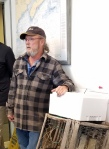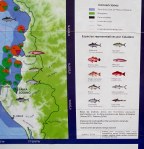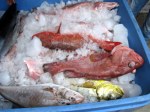Do you know where YOUR fish came from?
Probably not, but there are interesting exceptions.
 In some cases, like live shellfish, the provenance – exactly where caught, by whom and when – is noted on a tag. Copps Island Oysters purchased at the Greenwich CT Farm market come with such a little tag, even if you’re only buying a dozen. (Great oysters, by the way http://www.coppsislandoysters.com ).
In some cases, like live shellfish, the provenance – exactly where caught, by whom and when – is noted on a tag. Copps Island Oysters purchased at the Greenwich CT Farm market come with such a little tag, even if you’re only buying a dozen. (Great oysters, by the way http://www.coppsislandoysters.com ).
On a recent voyage to Halifax, Nova Scotia, myMEGusta went on a foodie walking tour, which included a stop at Goldwater Seafoods, a modest dockside store, backed up by a worldwide seafood shipping business, and with many stories to tell.http://www.goldwaterseafoods.com/
The proprietor explained how the lobster industry works: very entrepreneurial, potentially dangerous, and most definitely not for the faint of heart, including when rubber banding those claws.
Who knew, for example, that the pots have to be tended daily, rain or shine, snow or squall, to harvest the creatures and bring them to the pound. There they are kept healthy, and live out their lives until being shipped out in the leaner months when fishing is either not possible or productive enough to keep up supply to stores and restaurants.
Or, that lobstermen (and they are mostly men) keep mum on exactly where they have found where the crustaceans like to congregate (and go into traps), or their exact catch. It’s almost like the white truffle hunters in Italy, except that no dogs are involved.
On a very different cruise last spring, myMEGusta visited Bahia Solano, Colombia, a sleepy fishing village on the Pacific Coast, extremely rustic, but with a claim to fame as a tourist resort: not exactly like Puerta Vallarta with luxury hotels and great wine lists, but simple inns catering to serious sport fishermen (one website calls them “adventurists”) and scuba divers, mostly from Europe.
The other economic mainstay of the village is fishing within the legally designated artisanal fishing district, several miles off the coast where larger commercial vessels are forbidden to operate. The artisanal fishermen comply with regulations on the size of their boats, and their fishing methodology is limited to more traditional means than the industrial ships.
While they catch plenty of average fish, which is all consumed locally, their big win is the finer fish, red snapper, tuna, and such, which are sent to the coop, iced down, and then flown to markets all over South America and the world.
When you see/hear how hard all of these folks work to capture the sea’s bounty for us, particularly in cold, Northern waters or the choppy Pacific, never mind the logistics involved in getting the catch to us, the cost of top quality seafood makes very good sense!





Very informative as usual. One big problem is identifying fish properly. There are so many local names, and so many names invented to lure customers. It is difficult to identify the species once filleted and packaged. Fortunately shell fish in the USA must be clearly labeled as you stated and restaurants must keep the tags sorted by date 6 months.